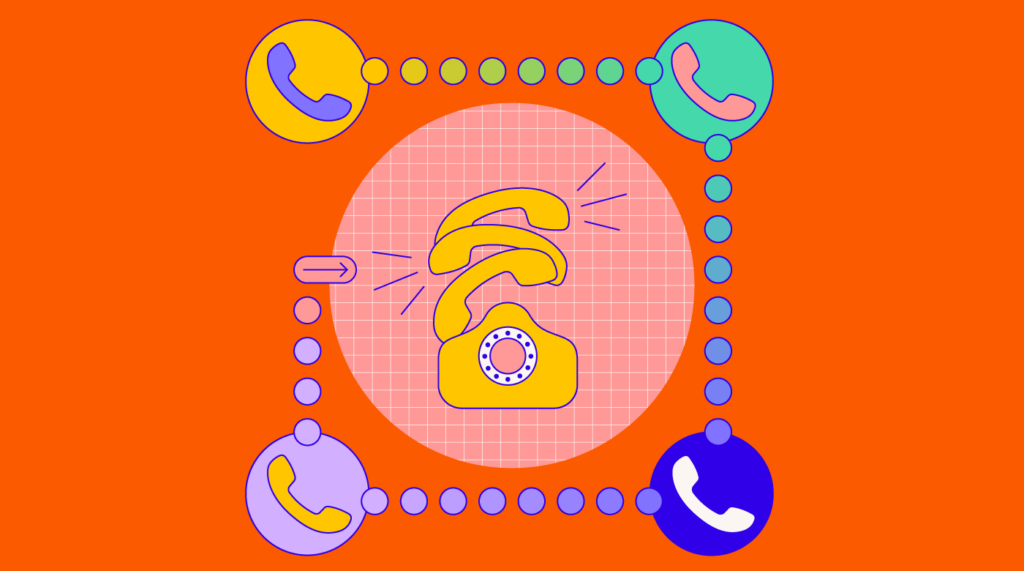For 68% of surveyed customers (data from 2021), the phone is still the number-one preferred form of contact with a company when seeking help with a purchasing decision.
Even though there are so many communication channels out there, the phone is still important when it comes to customer support. That’s because an inbound call center gives customers this crucial feeling of personal, direct communication with the company. And, as market data shows, that’s vital to the customer experience. A chatbot, while quick and convenient, will never offer this feature.

This is why inbound call centers can be a great investment, especially if your company handles several hundreds of incoming calls every month.
What Is An Inbound Call Center?
An inbound call center can be a standalone solution, but more often than not, it’s an integral part of a company’s contact center infrastructure. In general, inbound call center agents are responsible exclusively for answering phone calls from both current and potential customers. In a moment, I will explain the main differences between an inbound and an outbound call center.
Now, because inbound call centers deal with incoming calls, they play a massive role in ensuring customer satisfaction. They answer frequent questions, provide the necessary information, support the callers (e.g., concerning order processing), and can even play a part in the selling process. From this perspective, a good inbound call center is a prerequisite to your company’s success, provided that’s how you communicate with customers/users.
That said, if your call volumes are continually going up, you need to think about expanding your contact center’s operations and introducing some self-service options (e.g., a chatbot). You can also consider call center outsourcing as an alternative to your in-house operations.
An inbound call center is typically responsible for four major questions related to customer service:
- Call routing and directing callers: This is the first stage in every incoming phone call. Depending on the purpose of the call, the inbound call center directs a given person to the right agent or department. Today, thanks to modern contact center solutions, this part of work is automated through IVR (Interactive Voice Response). According to the study I mentioned in the introduction, the vast majority of callers are rerouted at least once:

- Help desk and technical support: This is a big part of inbound call center services. The help desk supports callers with their technical issues with the product or with the service. Good tech support can help you win customer loyalty and mitigate customer churn.
- Inbound sales: In 2023, many companies still offer sales over the phone. Insurance and travel services are good examples. When a customer calls your company to place an order, it’s still a job for the inbound call center. This question is especially important in seven market sectors:

- Renewals and service upgrades: From time to time, we all have to go through this—you need to upgrade your service because your needs have changed since you ordered it for the first time (perhaps many years ago). That’s also a part of the job inbound call centers do on a daily basis.
Is this a closed list? No. It all depends on your company’s profile and the needs of your customers/users. However, the hard and fast rule is this - an inbound call center deals with incoming phone calls only.
Inbound vs. Outbound Call Center
The truth is, if you run a big company, you need both. While an inbound call center deals with incoming calls, the outbound one helps you when it comes to outgoing calls, primarily to potential customers. Major outbound call center services comprise:
- Telemarketing and cold calls: If you want your reps to call current and potential customers with new offers, special promotions, and new products, that’s a job for an outbound call center. Additionally, when it comes to lead generation, a good customer relationship management (CRM) tool is essential.
- Market research: Sometimes, sales teams need to conduct research to discover the potential for a new product or service or to simply ask about customer satisfaction with a recently purchased product.
- Proactive notifications: This is a tactic media providers frequently use. They call customers to inform them about recent changes or potential issues with the account.
There are two major inbound call center solutions:
- An inbound-only call center: This is when your inbound call center is a completely separate entity with its own phone system and phone number.
- A comprehensive call center: This is when inbound calls are solved within the same contact center infrastructure, possibly even through the same agents handling the outbound calls. This model is more popular among companies pursuing the omnichannel model (where all communication channels are integrated to create a seamless customer experience).
Let’s have a look at the pros and cons of the first option.
Pros Of An Inbound-Only Call Center
The biggest advantage of an inbound-only call center is that it offers (usually) shorter waiting times compared to a large contact center, where everything happens under one roof. This is, of course, a huge advantage for your customers—no one wants to hang on the line endlessly! A short wait time frequently results in faster call resolution (aka handle time), which also contributes to a good customer experience.
Secondly, if you have agents or reps delegated just to handle incoming phone calls, you can train them to improve their skills and knowledge in this regard. That’s important because dealing with outgoing calls requires a different set of skills. For instance, inbound call center scripts don’t need to learn how to catch customers’ attention quickly the way outbound sales reps do. In fact, training call center reps is a much broader topic, so I encourage you to read out advice for building a world-class customer service team.
Cons Of An Inbound-Only Call Center
The biggest con of running a separate inbound call center is related to the costs of such a solution. A separate phone system, a separate support team, and perhaps even a separate location—all of that generates significant costs, so it’s rather an option for the biggest companies.
And, of course, you need to gather a team, which is not always easy with the global workforce shortages we have to struggle with right now.
How Do I Know if a Call Center Is Worth The Investment?
There is no one-fits-all answer to this question; it all depends on the number and the nature of customer interactions in your company. If you run a company with thousands of customers/users who prefer to call than write an email or chat with a chatbot, then definitely an inbound call center is worth the investment.
Analyze your current contact center operations, take a look at the major metrics, and see what customer retention charts look like. If you see that your company is overloaded with the number of incoming calls, the waiting times are long (28% of customers hang up after five minutes of waiting or less), and your company struggles with keeping your customer’s business, then I’d say you need an inbound contact center desperately.
I understand the scale of such a project. Thankfully, you can make your life easier by selecting the right inbound call center software that will do a lot of work for you. And secondly, I’d suggest you opt for a cloud-based contact center.
Call Center Alternatives
In general, there are just two alternatives to an in-house call center:
- Outsourcing: You can outsource both inbound and outbound call center operations to an external company that’s specialized in outbound services.
- Self-service options: Although the study I quoted shows customers are not always eager to use them, the fact is they can take some workload off your reps’ shoulders. Such self-service options are primarily smart assistants (chatbots and voice bots), knowledge bases, and customer portals.
The second option is definitely worth implementing, even if you already run a standalone inbound call center. Why? Chiefly because more and more customers are eager to use them, and they will soon expect companies to provide them. You better be ready when that moment comes!
Make The Most Of Your Inbound Call Center
In this article, you will find links to several other articles broadening the knowledge outlined in this post. If you’re thinking about expanding your call center operations, I strongly encourage you to take a look at them.
For more practical CX knowledge, sign up for our newsletter!


